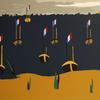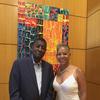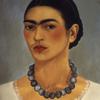Called the “Antichrist of Photography' by Ansel Adams, Controversial Hollywood Photographer William Mortensen Spotlighted at New York City Book & Ephemera Fair Next Week
- NEW YORK, New York
- /
- February 25, 2019
WILLIAM MORTENSEN: A VISIONARY PHOTOGRAPHER
THE NEW YORK CITY BOOK & EPHEMERA FAIR CELEBRATES HIS
GOLDEN HOLLYWOOD YEARS IN A SPECIAL EXHIBITION, “CELLULOID BABYLON”
March 9 & 10, 2019
His work was startling and new. It had the power to surprise, shock and even haunt the viewer. William Mortensen was a highly controversial artist during his lifetime, stirring up the photographic world in the early twentieth century with images that were in direct opposition to the prevailing realism of his contemporaries. Today, we recognize Mortensen as the trailblazer he was --the first to use highly manipulated imagery in a way that wasn’t embraced until Photoshop almost a century later.
The New York City Book & Ephemera Fair, will mount a special exhibition of the artist’s work when it returns to the Sheraton Central Park/Times Square hotel, (7th Avenue, between 52nd & 53rd Streets) March 9 & 10. Curated by author/art historian, Brian Chidester, courtesy of the Stephen Romano Gallery, “Celluloid Babylon” draws from the artist’s Hollywood years in the 1920s and 30s.
Mortensen, the son of Danish-born parents, was the first photographer to take still-photos of actors on Hollywood sets, rather than photographing film stars like Jean Harlow, Rudolph Valentino and John Barrymore in posed studio settings. It all started, when, as a costume designer on Cecile B. DeMille’s epic Hollywood film, The King of Kings, the artist decided one day to snap photographs of the actors while moving around in the opulent costumes he had designed. Director DeMille immediately saw the marketing potential of having such images available prior to the film’s release. The movie lobby card was born!
Mortensen was known for retouching prints (though seldom negatives) with an abrasion process that used razor-blades, carbon pencil, ink, eraser and pumice to create manipulated images almost indistinguishable from etchings or paintings. His subject matter was theatrical, gothic, and often strange. “A Pictorial History of Witchcraft and Demonology,” and “Monsters and Madonnas,” are two of his best-known works.
Mortensen clashed openly with the better-known Ansel Adams and his New Realism contemporaries in the 1930s and 40s. Adams’ classic and stately images of Rocky Mountain peaks and valleys at sunset were a world away from Mortensen’s satanic rituals, ancient Hindu goddesses, witch doctors with scary masks and vengeful gorillas. Ansel Adams wrote, “photography is an objective expression and a record of actuality,” – a philosophy which became even more influential after the hard realities of World War II. Mortensen disparaged such “literal recordings,” calling them “a good beginning, but not an end in itself.” Adams called him the “Antichrist of Photography.”
Today, Mortensen’s altered images are right at home in a world where we are surrounded by fantasy figures in both movies and video games. His work finds an affinity with all forms of story-telling, whether they be fantasy, horror, or mysticism. He was able to tap into that euphoric aspect that humans share with each and every image. From his early movie lobby cards, which were all about selling fantasies, Mortensen then developed a private art style that took Hollywood iconography into a more timeless space. Anything could be a part of Mortensen’s fictional ecosystem so long as it was emotionally and visually rich. Celluloid Babylon is a testament to this vision. He predicted the imagery to come in the 21st century.
Fair hours are:
Saturday, March 9, 2019, 8AM – 4PM
Sunday, March 10, 2019, 9AM – 3PM
Where:
Sheraton Central Park / Times Square
811 7th Avenue
New York, NY, 10019
Admission – $15 each day, with student ID – Free
Pre-purchase a weekend pass online and save $5 or register for a complimentary pass for Sunday, March 10 – http://bit.ly/NYCBook19.
Shown above is Untitled (Fay Wray with Masks) circa 1928. William Mortensen (1897 - 1965, American) Silver Print
Mortensen's initial sojourn to Hollywood in 1922 was to act as chaperon to Fay Wray who also came from Utah and whose sister Mortensen was dating. Upon a surprise visit from her mother in 1930, this and several other photographs from this session were discovered and destroyed by her mother, and only a handful of prints remain. Mortensen, who was one of the most sought -after photographers in Hollywood at the time, was blacklisted by the Hollywood studios and forced to move to Laguna Beach where he started his school and studio.
The Old Hag and Incubus circa 1928. William Mortensen (1897 - 1965, American) Unique Bromide Print
This image was probably shot at the Western Costume Company - the most widely used costume company in Hollywood in the 1920's where William Mortensen, had an entire floor of costumes and props at his disposal. In this photograph, the "hag" is (according to Mortensen) the cleaning lady who happened to walk in, and the "incubus" is wearing a mask William Mortensen had previously made for director Todd Browning for his classic 1928 film "West of Zanzibar" staring Lon Chaney. This print is the only known one on existence of this image, and is a variation of one of his most famous work "Preparation for the Sabbath".
Sappho the Poetess of Old Greece
circa 1928. William Mortensen (1897 - 1965, American)
Bromide Print with Pencil.
The model for this image is Jacqueline Logan who appeared in the 1927 Cecil B. DeMille film "King of Kings" as Mary Magdalene. William Mortensen was the still photographer for this film, which for the first time took promotional stills as the scenes were shot instead of re-staging the scenes for photography.






__2016_100x100_c.jpg)


![Peter Paul Rubens (Flemish, 1577–1640), After Titian (Tiziano Vecelli) (Italian [Venetian], c. 1488–1576), Rape of Europa, 1628–29. Oil on canvas, 71 7/8 x 79 3/8 in. Peter Paul Rubens (Flemish, 1577–1640), After Titian (Tiziano Vecelli) (Italian [Venetian], c. 1488–1576), Rape of Europa, 1628–29. Oil on canvas, 71 7/8 x 79 3/8 in.](/images/c/e2/2e/Jan20_Rape_of_Europa100x100_c.jpg)






